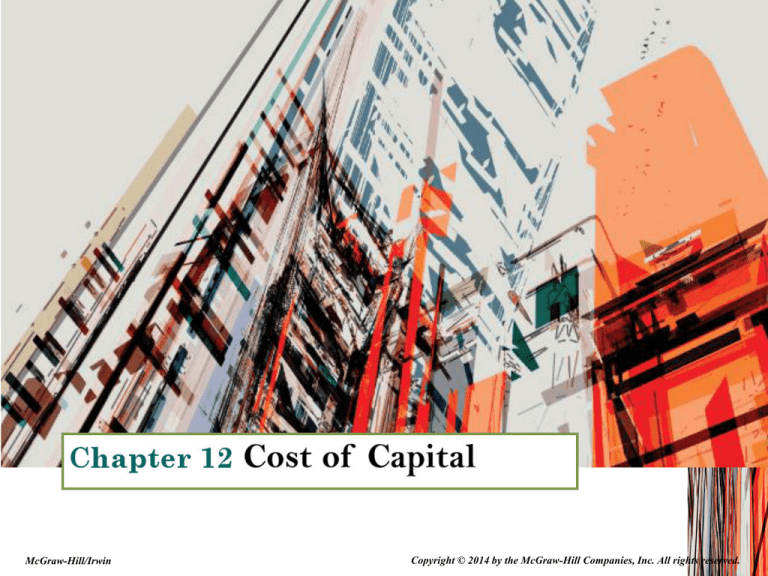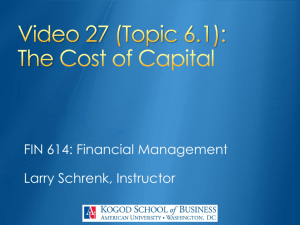
McGraw-Hill/Irwin
Copyright © 2014 by the McGraw-Hill Companies, Inc. All rights reserved.
Key Concepts and Skills
• Know how to determine:
– A firm’s cost of equity capital
– A firm’s cost of debt
– A firm’s overall cost of capital
• Understand pitfalls of overall cost of
capital and how to manage them
12-2
Cost of Capital Basics
• The cost to a firm for capital funding = the
return to the providers of those funds
– The return earned on assets depends on the
risk of those assets
– A firm’s cost of capital indicates how the
market views the risk of the firm’s assets
– A firm must earn at least the required return to
compensate investors for the financing they
have provided
– The required return is the same as the
appropriate discount rate
12-3
Cost of Equity
• The cost of equity is the return required by
equity investors given the risk of the cash
flows from the firm
• Two major methods for determining the
cost of equity
- Dividend growth model
- SML or CAPM
Return to
Quick Quiz
12-4
The Dividend Growth Model
Approach
Start with the dividend growth model
formula and rearrange to solve for RE
D1
P0
RE g
RE
D1
g
P0
12-5
Example: Dividend Growth Model
• Your company is expected to pay a dividend of
$4.40 per share next year. (D1)
• Dividends have grown at a steady rate of 5.1% per
year and the market expects that to continue. (g)
• The current stock price is $50. (P0)
• What is the cost of equity?
4.40
RE
.051 .139
50
12-6
Example: Estimating the Dividend
Growth Rate
• One method for estimating the growth rate
is to use the historical average
Year
2009
2010
2011
2012
2013
Dividend
Percent Change
1.23
(1.30 – 1.23) / 1.23 = 5.7%
1.30
(1.36 – 1.30) / 1.30 = 4.6%
1.36
(1.43 – 1.36) / 1.36 = 5.1%
1.43
(1.50 – 1.43) / 1.43 = 4.9%
1.50
Average = (5.7 + 4.6 + 5.1 + 4.9) / 4 = 5.1%
12-7
Advantages and Disadvantages of
Dividend Growth Model
• Advantage – easy to understand and use
• Disadvantages
– Only applicable to companies currently paying
dividends
– Not applicable if dividends aren’t growing at a
reasonably constant rate
– Extremely sensitive to the estimated growth rate
– Does not explicitly consider risk
12-8
The SML Approach
• Use the following information to compute
the cost of equity
– Risk-free rate, Rf
– Market risk premium, E(RM) – Rf
– Systematic risk of asset,
RE Rf E ( E( RM ) Rf )
12-9
Example: SML
•
•
•
•
Company’s equity beta = 1.2
Current risk-free rate = 7%
Expected market risk premium = 6%
What is the cost of equity capital?
RE 7 1.2( 6 ) 14.2%
12-10
Advantages and Disadvantages of
SML
• Advantages
– Explicitly adjusts for systematic risk
– Applicable to all companies, as long as beta is available
• Disadvantages
– Must estimate the expected market risk premium,
which does vary over time
– Must estimate beta, which also varies over time
– Relies on the past to predict the future, which is not
always reliable
12-11
Example: Cost of Equity
• Data:
–
–
–
–
–
–
Beta = 1.5
Market risk premium = 9%
Current risk-free rate = 6%.
Analysts’ estimates of growth = 6% per year
Last dividend = $2.
Currently stock price =$15.65
– Using SML: RE = 6% + 1.5(9%) = 19.5%
– Using DGM: RE = [2(1.06) / 15.65] + .06
= 19.55%
12-12
Cost of Debt
• The cost of debt = the required return on a
company’s debt
• Method 1 = Compute the yield to maturity
on existing debt
• Method 2 = Use estimates of current rates
based on the bond rating expected on new
debt
• The cost of debt is NOT the coupon rate
12-13
Example: Cost of Debt
Current bond issue:
–
–
–
–
30
-1253.72
1000
60
CPT I/Y
N
PV
FV
PMT
4.45%
15 years to maturity
YTM = 4.45%*2 = 8.9%
Coupon rate = 12%
Coupons paid semiannually
Currently bond price =
$1,253.72
12-14
Component Cost of Debt
• Use the YTM on the firm’s debt
• Interest is tax deductible, so the after-tax
(AT) cost of debt is:
R D , AT R D ,BT ( 1 TC )
• If the corporate tax rate = 40%:
RD , AT 8.9%( 1 .40 ) 5.34%
Return to
Quick Quiz
12-15
Cost of Preferred Stock
• Preferred pays a constant dividend every
period
• Dividends expected to be paid forever
• Preferred stock is a perpetuity
D
RP
P0
• Example:
– Preferred annual dividend = $10
– Current stock price = $111.10
RP = 10 / 111.10 = 9%
12-16
Weighted Average Cost of Capital
• Use the individual costs of capital to
compute a weighted “average” cost of
capital for the firm
• This “average” = the required return on the
firm’s assets, based on the market’s
perception of the risk of those assets
• The weights are determined by how much
of each type of financing is used
Return to
Quick Quiz
12-17
Determining the Weights for the
WACC
• Weights = percentages of the firm that
will be financed by each component
• Always use the target weights, if
possible
– If not available, use market values
12-18
Capital Structure Weights
• Notation
E = market value of equity
= # outstanding shares times price per share
D = market value of debt
= # outstanding bonds times bond price
V = market value of the firm = D + E
• Weights
E/V = percent financed with equity
D/V = percent financed with debt
Return to
Quick Quiz
12-19
WACC
WACC = (E/V) x RE + (P/V) x RP + (D/V) x RD x (1- TC)
Where:
(E/V) = % of common equity in capital structure
Weights
(P/V) = % of preferred stock in capital structure
(D/V) = % of debt in capital structure
Component
costs
RE = firm’s cost of equity
RP = firm’s cost of preferred stock
RD = firm’s cost of debt
TC = firm’s corporate tax rate
12-20
Estimating Weights
Given:
•
•
•
•
•
Component Values:
• VE = $50 x (3 m) = $150m
Stock price = $50
3m shares common stock • VP = $25m
• VD = $75m
$25m preferred stock
• VF = $150+$25+$75=$250m
$75m debt
40% Tax rate
Weights:
E/V = $150/$250
P/V = $25/$250
D/V = $75/$250
= 0.6 (60%)
= 0.1 (10%)
= 0.3 (30%)
12-21
WACC
Component
Debt (before tax)
Preferred Stock
Common equity
W
0.30
0.10
0.60
R
10%
9%
14%
WACC = E/V x RE + P/V x RP + D/V x RD (1 - TC)
WACC = 0.6(14%) + 0.1(9%) + 0.3(10%)(1-.40)
WACC = 8.4% + 0.9% + 1.8% = 11.1%
12-22
Table 12.1
12-23
Factors that Influence a
Company’s WACC
• Market conditions, especially interest rates,
tax rates and the market risk premium
• The firm’s capital structure and dividend
policy
• The firm’s investment policy
– Firms with riskier projects generally have a
higher WACC
12-24
Eastman Chemical – 1
Equity Data
Source: http://finance.yahoo.com
12-25
Eastman Chemical – 2
Dividend Growth
Source: http://finance.yahoo.com
12-26
Eastman
Chemical 3
Beta and
Shares
Outstanding
Source: http://finance.yahoo.com
12-27
Eastman
Chemical 4
Dividends
Source: http://finance.yahoo.com
12-28
Eastman Chemical - 5
Cost of Equity - SML
• Beta:
Yahoo Finance
Value Line
2.31
1.25
(1.25 is a more reasonable value)
• T-Bill rate = 0.05% (Yahoo Finance bonds section)
• Market Risk Premium = 7% (assumed)
• Cost of Equity (SML) = 0.05% + (7%)(1.25)
= 8.80%
RE Rf E ( E( RM ) Rf )
12-29
Eastman Chemical - 6
Cost of Equity - DCF
• Growth rate
• Last dividend
• Stock price
• Cost of Equity (DCF) =
7.67%
$1.04
$53.74
D1
RE
g
P0
$1.04(1.0767)
.0767
53.74
RE 9.75%
RE
12-30
Eastman Chemical - 7
Cost of Equity
Cost of Equity Method
Estimated Value
SML
8.80%
DCF
9.75%
Average
9.28%
12-31
Eastman Chemical - 8
Bond Data
Source: http://www.sec.gov
12-32
Eastman Chemical - 9
Cost of Debt
• For Eastman, the cost of debt is similar when using either
book values or market values.
12-33
Eastman Chemical - 10
WACC
Capital structure weights (market values):
E = 136.92 million x $53.74 = $7.358 billion
D = 1.661 billion
V = $7.358 + 1.661 = 9.019 billion
E/V = 7.358 / 9.019 = .82
D/V = 1.661 / 9.019 = .18
Tax rate (assumed) = 35%
WACC = .82(9.28%) + .18(3.81%)(1-.35)
= 8.02%
12-34
Risk-Adjusted WACC
• A firm’s WACC reflects the risk of an average
project undertaken by the firm
– “Average” risk = the firm’s current operations
• Different divisions/projects may have different
risks
– The division’s or project’s WACC should be adjusted
to reflect the appropriate risk and capital structure
Return to
Quick Quiz
12-35
Using WACC for All Projects
• What would happen if we use the WACC for
all projects regardless of risk?
• Assume the WACC = 15%
Project
A
B
IRR
14%
16%
Project Beta
0.60
1.20
WACC=15%
Reject
Accept
12-36
Using WACC for All Projects
• Assume the WACC = 15%
• A project’s required return is calculated
using the SML and the project’s Beta
• Adjusting for risk changes the decisions
Project
A
B
IRR
14%
16%
Required
Decision
Return
WACC=15%
Risk Adj
11.8%
Reject
Accept
16.6%
Accept
Reject
12-37
Divisional Risk & the Cost of Capital
12-38
Pure Play Approach
• Find one or more companies that specialize
in the product or service being considered
• Compute the beta for each company
• Take an average
• Use that beta along with the CAPM to find
the appropriate return for a project of that
risk
• Pure play companies can be difficult to find
Return to
Quick Quiz
12-39
Subjective Approach
• Consider the project’s risk relative to
the firm overall
– If the project is riskier than the firm, use a
discount rate greater than the WACC
– If the project is less risky than the firm,
use a discount rate less than the WACC
Return to
Quick Quiz 12-40
Subjective Approach - Example
Risk Level
Very Low Risk
Discount Rate
WACC – 8%
6%
Low Risk
WACC – 4%
10%
Same Risk as Firm
WACC
14%
High Risk
Very High Risk
WACC + 6%
WACC + 10%
20%
24%
12-41
Quick Quiz
• What are the two approaches for computing the cost of
equity? (Slide 12.5)
• How do you compute the cost of debt and the after tax
cost of debt? (Slide 12.16)
• How do you compute the capital structure weights
required for the WACC? (Slide 12.20)
• What is the WACC? (Slide 12.18)
• What happens if we use the WACC as the discount rate
for all projects? (Slide 12.36)
• What are two methods that can be used to compute
the appropriate discount rate when WACC isn’t
appropriate? (Slide 12.40 and Slide 12.41)
12-42
Chapter 12
END
12-43






